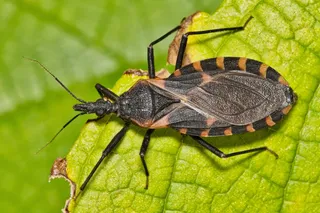As most newlyweds quickly learn, intimate relationships, even the most blissful, can buzz with tension. Couples typically find themselves struggling over money, in-laws, ex-lovers, and how much the woman's placenta should grow when she gets pregnant. That last one is a killer. The guy wants his woman to have a fast-growing placenta, while the woman does all she can to keep it down to a reasonable size.
Of course, the fight over the placenta doesn’t exactly take place out in the open. The average man, if asked what he thinks of his wife’s placenta, would probably say he hasn’t given it a thought. Instead the placenta conflict gets played out, unbeknownst to either person, inside the woman’s body. A trange genetic process called gene imprinting is responsible. And their existence is only one small example of how males and females have conflicting evolutionary goals. Understanding that the struggle takes place can explain a lot of strange behavior and physiology. And it can even explain how we came to be susceptible to certain horrific diseases.
At first it might seem unlikely that men and women do have conflicting evolutionary goals. The point of life, according to evolutionary theorists, is for organisms to pass on copies of their genes to succeeding generations. Some organisms, such as cockroaches, do this by producing as many offspring as possible, hoping some will survive. Others, such as elephants and humans, have fewer young but shower them with care.
STAY-AT-HOME-DADS
Conflict between males and females takes a complicated turn in the rare species with high “male parental investment.” In such species, a male instinctually takes care of youngsters he thinks are his own. He mates with someone, and babies appear an appropriate length of time later, so he protects them from predators and takes them to ice-skating lessons. A lot of bird species fit this profile. Sometimes the male does more parenting than the female. At the time of birth, she has invested far more energy in the gestation than he has, but afterward the tide gradually turns. In those cases, what should a heartlessly practical female do if she wants to maximize her reproductive success? She should figure out the exact moment when he’s spent more cumulative energy than she has on passing on copies of his genes via these offspring. When that moment arrives, she should abandon the youngsters. He will likely continue taking care of them, guaranteeing her reproductive success and leaving her free to start a new round of reproduction with someone else. —R.S.
So yes, both mom and dad want their kid to survive. And in monogamous species, when the father can be pretty sure it really is the kid, he may well cooperate with the mother. But that’s not quite the way it is in more polygamous animal species such as orangutans, nor was it that way, say many evolutionary biologists, among our own ancestors. Those males want their offspring to survive at any cost—even at the cost of the female’s health and future fertility with other males. For example, if the male can figure out a way to make the female spend most of her food energy making the offspring grow big and strong, that’s okay, even if she starves. That’s where the struggle over the placenta comes in: men and other mammals pass on genes to their unborn children that encourage the mother’s placenta to grow big, nourishing the fetus at the mother’s expense and at the expense of her future kids with other guys.
Females want their offspring to survive too, but not at the risk of their own lives or their fertility. For example, in mammals, nursing inhibits ovulation. So a mammal mom wouldn’t nurse her young for the rest of her life, even if doing so greatly increased its chances of survival. Otherwise, she might never again ovulate, become pregnant, and bear more young.
This conflict is played out viciously among fruit flies. Rather than growing old in each other’s arms, drosophila mate with multiple partners, none of whom stick around for a second date. And look at what they’ve come up with: male semen contains toxins that kill the sperm of other males. When a male fly mates with a female who has recently had sex with someone else, his spermicide goes to work, killing competitors’ sperm. That’s a great adaptation, but unfortunately the stuff is toxic to the female and gradually harms her health. This doesn’t bother the male at all. It increases his evolutionary fitness, and he’s never going to see her again.
William Rice, an evolutionary geneticist then at the University of California at Santa Cruz, did a wonderfully slick experiment in which he kept female fruit flies from evolving while letting the males compete against each other. After 40 generations, the evolutionary winners were males with the strongest toxic punch in their semen. Females who mated with them had a shorter life expectancy.
The same sort of coevolutionary arms race happens in humans and other mammals. As a result, we have developed a bizarre set of genes called imprinted genes, that seem to violate the basic tenets of genetics.
Think back to Gregor Mendel and high school biology. That most monkish of monks taught that genetic traits are coded for by pairs of genes, one from each parent. He figured out how the pairs of genes interact to influence the organism, depending on whether the pair have identical or differing messages. This is the world of dominant and recessive traits. According to Mendel, it doesn’t matter which parent contributed which genetic message. Whether the offspring gets the vanilla version of a gene from a mother and the chocolate version from the father or the other way around, the trait coded for by the pair of genes will look the same.
Imprinted genes violate the textbook Mendelian rules. With imprinted genes, only the gene from one parent has input—the matching gene from the other parent is silenced, losing its influence over the trait expressed. Most experts in this new field believe that there are only a couple hundred of these genes in humans, but they can be quite influential.
Reports of human monogamy are greatly exaggerated.
About half the genes in question have something to do with growth—of the placenta, the fetus, or the newborn. And the genes derived from the father favor greater, faster, more expensive growth, while the maternally derived genes counter that exuberance. As the evolutionist David Haig of Harvard first suggested in 1989, these human imprinted genes are a case of intersexual competition, fruit fly sperm wars redux.
The first battleground is the placenta, a tissue that can seem more than a little creepy. It’s only partially related to the female, but it invades (a term used in obstetrics) her body, sending tentacles toward her blood vessels to divert nutrients for the benefit of a growing fetus. The placenta is also the scene of a pitched battle, with paternally derived genes pushing it to invade more aggressively while maternally derived genes try to hold it back. How do we know? In rare diseases, maternal or paternal genes related to placental growth are knocked out of action. Lose the paternal input and the antigrowth maternal component is left unopposed—the placenta never invades the mother’s endometrium, so the fetus has no chance to grow. In contrast, remove the maternal input, leaving those paternal genes unopposed, and the placenta grows into a stupendously aggressive cancer called choriocarcinoma.
The imprinting struggle continues during fetal development. One gene, which codes for a powerful growth-stimulating hormone in mice and humans, is expressed only by paternally derived genes. This is a classic case of dad pushing for maximal fetal development. In mice (though not in people), the mother counteracts the pro-growth tumult by expressing a gene for a cellular receptor that regulates the growth hormone’s effectiveness. Thrust and parry.
BRAIN GENES
Mom wants you to be clever, but dad cares more about your metabolism. At least, that’s the way the evidence of gene imprinting points. Experiments with mice show that some maternally expressed genes favor a bigger cortex, the intellectual part of the brain. Mutations that knock out those maternally derived genes cause retardation. In contrast, some paternally expressed genes favor growth of the hypothalamus, which controls unconscious body functions.
How do these imprinted genes related to brain function fit into the scheme of intersexual warfare? Instead of the usual scenario, in which dad wants more growth while mom wants less, each parent’s genes favor a different kind of growth. Does a female enhance her future health and fertility by supplying junior with a thick cortex and super SAT scores? Does a bigger hypothalamus produce a kid who is able to sap more of mom’s resources? No one knows but Eric Keverne, of the University of Cambridge, in England, who has done much of the work on brain-related imprinted genes, continues to wrestle with these intriguing findings, trying to fit them into the framework of intersexual warfare. Meanwhile, some evolutionary biologists speculate that the traits might have evolved for entirely different reasons. —R. S.
Once a baby is born, imprinted genes take a particularly impressive turn. Certain paternally expressed genes help make kids active nursers. On the surface, this looks like another example of the usual picture: faster development at the cost of mom’s lactational calories. But now we’re talking about imprinted genes that influence behavior. Other genes influence brain development in even stranger ways (see Brain Genes (above).
The discovery of imprinted genes may pave the way for curing a number of unpleasant diseases involving tumors, infertility, and fetal overgrowth or underdevelopment. But philosophically, the findings are disturbing. They appear to have some deflating implications about human nature. Among fruit flies, sperm-war genes show that males care little about the females’ future. What about us? “In sickness and in health,” we promise, “until death do us part.” We’re the species that came up with Jessica Tandy and Hume Cronyn. For monogamous animals, the future health and fertility of the female is as much in the male’s interest as hers. So what are these imprinted genes doing in a human couple pondering which appetizers to serve at their golden wedding anniversary?
The answer is that reports of our monogamy are greatly exaggerated. Features of human anatomy and physiology argue against it. Most human cultures allow polygamy. And most studies, ranging from genetic paternity tests to Cosmo questionnaires, suggest that there’s a lot of action going on outside the pair-bond, even in monogamous societies. We have more in common with fruit flies than commonly believed. Mind you, we’re not one of the more polygamous species around. Even the busiest patriarchs weigh in with only a few hundred kids.)
SELF-CONSCIOUS SCRUB JAYS
When biologists talk about male orangutans “realizing” that they have less to lose in mating than females, or female scrub jays “calculating” exactly when to abandon their young to a caring father, they’re speaking metaphorically. Except for the most cognitively sophisticated primates, animals don’t sit there with an evolution textbook and a calculator, strategizing consciously. Instead phrases like “the scrub jay wants to do this, decides that this is the right time,” and so on, are shorthand for the more correct but cumbersome, “Over the course of evolution, scrub jays who, at least in part through genetically influenced mechanisms, are better able to optimize the timing of their behavior leave more copies of their genes, thus making this attribute more prevalent in the population.” Personifying the animals is just an expository device agreed upon to keep everyone from falling asleep during conferences. —R. S.
Does nature have to be so bloody in tooth and claw and gene? Must everything be based on competition? Why can’t we all just get along? Here’s where the evolutionary biologists, with Bogartesque weariness, pull out the great clichés of their field. Biology isn’t about what should be, they explain, but what is. It’s a tough evolutionary world out there. It’s dog outreproduce dog.
But a recent experiment by Rice and evolutionary behaviorist Brett Holland hints that intersexual competition needn’t be inevitable. With careful manipulation, it can be derailed. The biologists isolated pairs of mating flies, forcing them to be monogamous. They then bred the offspring with the offspring of other such enforced monogamous pairs, continuing to maintain the monogamy. And after only 40 generations, the monogamous descendants produced less harmful seminal fluid. They also treated their mates with unusual courtesy—normal fruit-fly courtship looks like sexual harassment.
Once competition between males was no longer a selective force, producing toxic chemicals seems to have become a maladaptive waste of energy. Freed of the cost of intersexual warfare, these monogamous flies actually outbred the usual competitive flies.
Just imagine carrying out the same experiment in people. Isolate some humans and force them and their descendants into monogamy for a millennium, and we would probably begin to disarm our mammalian weapons of intersexual warfare, namely imprinted genes. They are an evolutionary burden, making possible some truly horrendous cancers. Remove their advantages by eliminating polygamy, and natural selection should edit them out.
Having arrived at what sounds like a surreal moral—an exhortation to remember the Sixth Commandment as part of the “Let’s Whip Choriocarcinoma by the Year 3000” campaign—it’s time to take a step back. Understanding how intersexual competition started with flies is relatively easy. Thanks to random genetic variability, some male flies stumbled into ever so slightly toxic sperm, which the females had to detoxify or die. And from there, the competition spiraled upward. The story of imprinted genes is a bit more complicated, but once paternally derived genes began pushing for the-hell-with-the-mom growth, the battle inevitably escalated. If the tribe next door shows up at the Paleolithic watering hole with clubs that seem just a wee bit on the big side for the purpose of bonking prey animals over the head, the home team will naturally respond by getting even bigger clubs, just in case. And soon we have a world with choriocarcinoma, toxic fruit-fly semen, and umpteen times the education budget buying $600 toilet seats for the military. As in so many other arenas of conflict, it’s easier to ratchet up than down.














